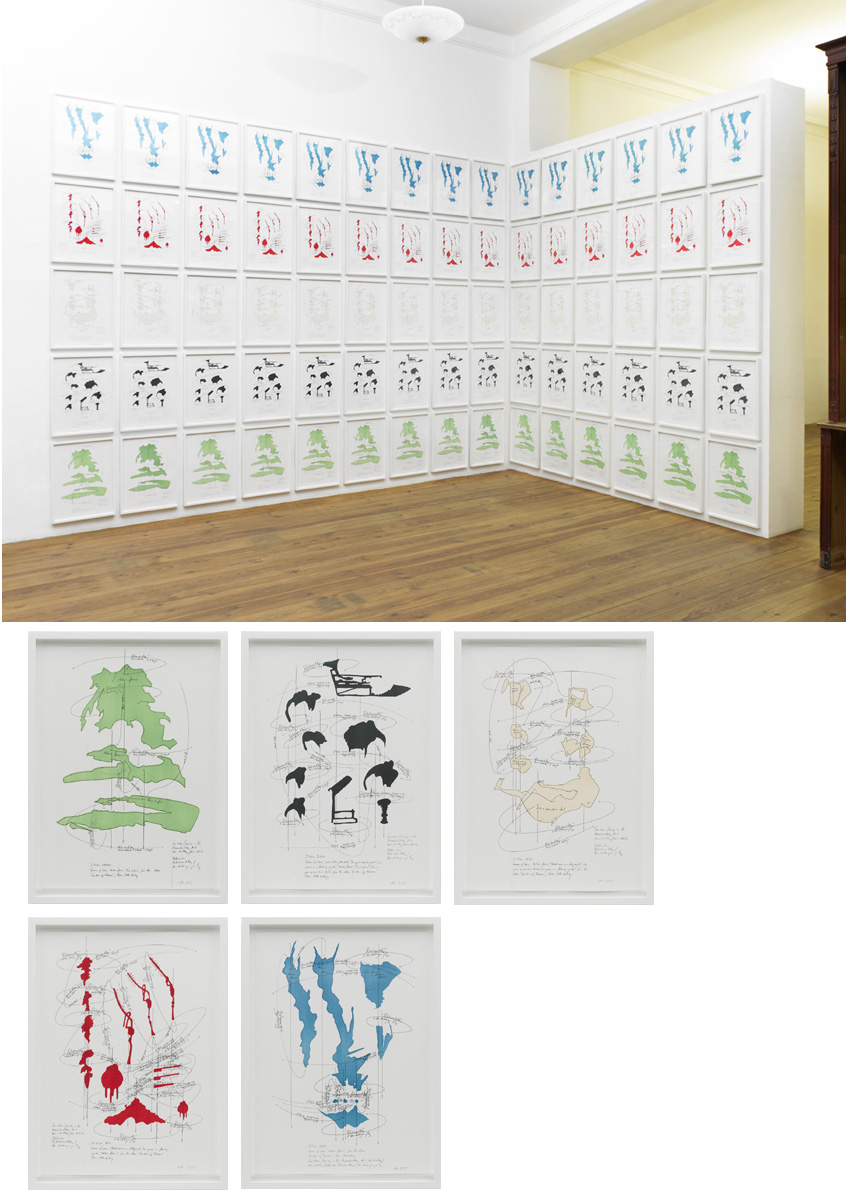
Jorinde Voigt
November 19, 2011 to February 29, 2012
Potsdamer Straße 97, 10785 Berlin
Jorinde Voigt
“Gardens of Pleasure”, 2011
Games of Love: 13 Views RED / 9 Views BLACK / 6 Views SKIN /
3 Views GREEN / 8 Views BLUE (Chinese erotic art / 17th Century) Countdown/ Countup in Sec.; Direction N-S; Wind direction/ Wind speed; Declination: Direction of Roation/ Rotation per day
Portfolio of 5 flat prints each annotated with ink
each 51 x 36 cm
On Inzisioni Buetten Paper 300g
Printer: Taborpresse, Berlin
Edition: 12, I, I, I
In her latest series, “Gardens of Pleasure”, 2011, Jorinde Voigt combines notation methods with lithography for the first time. The work is comprised of five different motifs, each in an Edition of 15. While the title and colours are printed onto the paper, Voigt draws in the dynamic lines and figures by hand, creating considerable variation within each motif. The 75 sheet focus on paintings in the catalogue, “The Chinese Garden of Lust – Erotic Art from the Bertholet Collection,” printed in conjunction with an exhibition of the same name at the East Asian Art Collection of the Berlin State Museums in Dahlem (2011).
Form and Colour
Every area of colour represents one glance at the paintings by the artist. While her first observation represents a rough impression of the motif, Voigt comes closer to capturing the structure of the scene depicted with every additional look. Using a fan-booklet of colour samples, Voigt determines the corresponding numbers of the colours of robes, pairs of lovers, wallpaper, furniture, etc. The synchronised portrayal of colour and form enables us to recognise some elements such as tables, mirrors, locks of hair, or feet. Voigt systematises what she sees by distancing each individual colour from its original context and reuniting the colours on one new sheet.
Movement
Voigt supplements her almost mimetic method of representation with fictive spatial and temporal data. The arrows and numbers noted provide the Geographical Direction north and south. In addition, the information labelled Direction of Rotation, Speed of Rotation and Number of Rotations per Day sets the drawing into an imaginary revolving motion. Voigt also marks every translated look at the painting as either Countup or Countdown, so that it is possible to follow the viewing process. The numbered areas of colour, however, are not always conducive to a linear reading.
Rhythm
By frequently zooming in towards an object, Voigt achieves a depth quite similar to musical processes. She varies and repeats colours and forms until the characteristics of the object being viewed are filtered out. In pursuing this approach, Voigt references the Chinese and Japanese painting traditions, in which hundreds of views of one motif were produced. This school of work has been documented in anthologies such as “100 Views of Mount Fujii” or “Yoshitoshi’s One Hundred Aspects of the Moon.”
Perception
Voigt’s exacting study of the paintings exhibited corresponds to the basic idea of her work, which is to grasp reality as a microcosm. The artist accumulates up to 100 views on each sheet of paper, leading the collages to resemble a scientific table. Central to Voigt’s work is her fascination with the formal characteristics of the Chinese paintings and their effect on the process of viewing. The explicitly erotic content of the so-called “Spring Pictures” recedes completely into the background. Instead, the drawings appear to be a mental construct with which to investigate human perception, raising questions about language, cognition, intuition and association.
